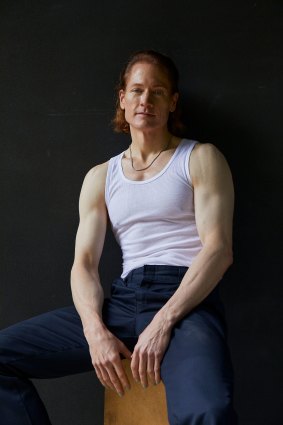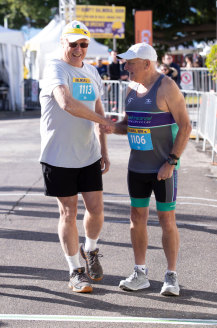Taking the blood of your 17-year-old son? Anti-ageing has gone too far

Save articles for later
Add articles to your saved list and come back to them any time.
One person’s hell is another’s person’s fun, so who am I to judge? Who are any of us to judge?
US tech entrepreneur Bryan Johnson’s idea of a good time is a diet of vegetables puréed into a grey-brown goop, a couple of dozen supplements plus a dash of lithium to start the day, snorting the odd vial of stem cells, counting the number of erections he has each night, monthly colonoscopies and trying out the blood of his 17-year-old son for a spot of bonding and in an effort to be 18 again.
Bryan Johnson, 45, with his 17-year-old son Talmage.Credit: Magdalena Wosinska for Bloomberg Businessweek
Truly, the 45-year-old, whose routine doesn’t accommodate lunch or evening social dinners, who was once suicidal and who has battled “regret, shame and disapproval” towards himself, insists his life is “joyful”.
Johnson, who also dyes his hair, gets weekly acid peels and has had fat scaffolding injections in his face, boasts that his $2 million annual pursuit of youth means he now ages slower than the average 10-year-old.
Each month, Johnson undergoes dozens of medical procedures, then tracks their effects on his body.Credit: Bloomberg Businessweek
Is it satire; is it art; is it deeply sad; is it pioneering science; or is he a soul-sucked, modern-day narcissus à la Dorian Gray?
Perhaps it’s all of the above, who can tell? Whatever it is, it is hard to look away. Johnson is clearly a complex human with, no doubt, complex motivations and complex relationships (after becoming ostracised from his family for leaving their religion, the Latter Day Saints, his son only moved in with him a year ago).
But his highly documented journey does beg the question of when is enough, enough? At what point does vanity or the pursuit of youth tip from healthy to sick?
“Obsession in your own health and appearance is often driven by deep insecurity, fear and even trauma,” says Dr Catriona Davis-McCabe, the president of the Australian Psychological Society. It can, she adds, “prevent a person from being circumspect or appreciative of how this obsession negatively affects themselves or those around them”.
That isn’t to say aspects of Johnson’s regime aren’t positive.
He spends one-hour winding down before going to bed, in a blacked-out room at 8pm every night. He has a daily hour-long exercise routine that consists of 25 exercises as well as thrice weekly HIIT sessions and hiking or playing sport on the weekend.
This part of his self-care routine is all rather sensible and has a decent grounding in evidence, says Dr Lindsay Wu, a senior research fellow who leads the Laboratory for Ageing Research at The University of New South Wales.
“The broader population can also achieve this without the need for expensive equipment or monitoring tools,” adds Wu, “and I’d especially emphasise the role of resistance exercise training to maintain muscle mass as being something that the elderly should especially focus on – this is incredibly important to their health.”
Beyond the basics, and of course having close bonds with others (which, would you believe, is possible without swapping blood), Wu sees little that is positive in Johnson’s pursuit.
The idea for the blood transfusions, for instance, where Johnson was injected with his son’s plasma, came from an experiment where an old and a young mouse were sewed together to share a circulatory system resulting in the older mouse becoming younger.
But, Wu points out, it was a proof-of-concept experiment to show that some “factor x” was released from the cells and was circulating in the blood of the young mouse that could improve the health of older mice.
“From there, the idea is to find out exactly what that factor is, and investigate that factor as a therapy,” he explains, adding that the purpose was not for transfusions to be used as a therapy.
And though the science on blood transfusions has progressed since then – separate studies have found plasma injections from young to old rodents can lead to functional improvements and limited lifespan extension – they most have not yet undergone peer-review and have been on short-lived animals, explains Christian Nefzger, a stem cell biologist and group leader at the University of Queensland’s Institute for Molecular Bioscience.
“Whether these results translate towards our species is yet to be seen,” Nefzger says. “As of now, they have no proven clinical benefits and could even be potentially harmful.”
That is before we consider that there is already a shortage of blood donations for people in vital need of one, let alone those wanting others’ blood as part of a vanity project.
The willingness to sacrifice children’s happiness and health to satisfy the neuroses of older people is also “pretty ugly”, Wu says.
“I’d also add that it’s ethically questionable, to say the least,” he adds. “It’s been a fairly consistent moral value that we should value the lives of children, young adults and the next generation more than those who have already had a chance to live a full life, as parents we are supposed to value the lives of our kids more than our own. Here we’ve got an example of a dad quite literally bleeding his child to satisfy his own vanity.”
Johnson has defended himself.
John Simmonds (R) at the Balmoral Burn on Sunday.Credit: Craig Golding
“What I do may sound extreme, but I’m trying to prove that self-harm and decay are not inevitable,” he told Bloomberg News.
But it’s not just vanity that Johnson’s pursuit reeks of, it’s a fear of ageing. Fear of ageing and ageism are likely to continue while we see ageing as a pathology, not a normal part of life.
Yet, losing our vitality is not an inevitability of age.
Last weekend, 79-year-old John Simmonds, competed in a 1200-metre ocean race before tackling the Balmoral Burn, which is a 420-metre race up one of Sydney’s steepest hills (it has a gradient to match the sharpest hills of the Tour de France).
Simmonds, who learned to swim at 49, and has competed in seven marathons, runs most days of the week for an hour, swims in the ocean three times a week and cycles at least once a week.
“That’s keeping me honest,” he says. “And while I can still keep running and cycling and swimming I’ll keep doing it. It’s wonderful.”
Ageing with grace, and good health and vitality are all possible and though that will mean different things to different people, and we will all be willing to take different risks and sacrifices to do that, the point is surely to enjoy our lives along the way. We don’t need to go to obsessive extremes to extend our health span and get more out of our lives.
Johnson likens himself to explorers like Ernest Shackleton. He wants to be inspiring and no doubt some will be excited by his pursuit. But, I can’t help but look at Johnson and feel sad.
Make the most of your health, relationships, fitness and nutrition with our Live Well newsletter. Get it in your inbox every Monday.
Most Viewed in Lifestyle
From our partners
Source: Read Full Article


